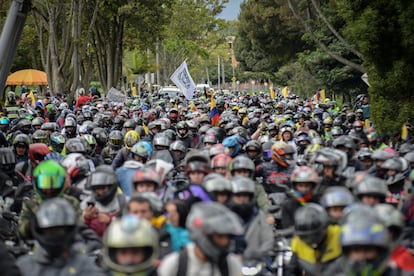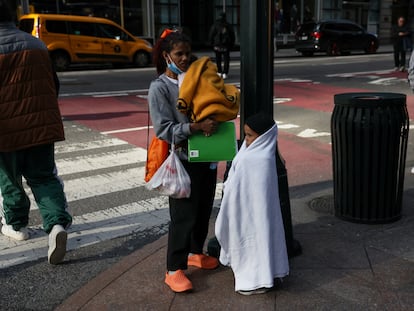Colombia: Motorcycle paradise or street hell?
The country now has more motorcycles than cars, posing a growing public health issue


Colombia has become a motorcycle paradise. The country is teeming with these practical and cost-effective two-wheeled vehicles, which have outnumbered cars for years. However, the surge has led to a wave of traffic accidents, in which motorcyclists are often both offenders and victims. Despite its scale, the problem hasn’t garnered much attention.
Motorcycles outnumbered cars in Colombia in 2023 with over 11 million registered, making up more than 60% of all vehicles. This poses a significant public health issue, as motorcyclists account for about 60% of traffic accident fatalities. The number of motorcyclists killed in Colombia rose from 3,234 in 2017 to 5,213 in 2023. Studies indicate they often exceed speed limits and engage in high-risk behaviors like weaving through traffic and not wearing helmets, leading to accidents involving pedestrians and bicyclists. “We live in a country where motorcyclists kill each other and others every day,” wrote journalist Mauricio García Villegas, after his father was run over and killed by a motorcycle.
The warning signs are clear. Colombia has the highest road accident rate at 15.5 per 100,000 residents among 35 countries in the International Transport Forum’s annual road safety report. While most countries are experiencing a decline in fatalities, Colombia stands out with a sharp increase, mainly due to motorcyclist fatalities that are above the global average. “[Colombia’s] upward trend in road deaths continued after the Covid-19 pandemic. The primary contributing factor is the continuous growth of motorcycles in Colombia,” stated the report.
The growing number of motorcycles is a nationwide trend, but it’s more visible in cities like Bogotá, with over seven million residents. A recent transportation survey shows a 19% increase in daily motorcycle trips, rising from 745,000 to 887,000 in the past four years. Motorcycles are an easy alternative where public transport is lacking, and are typically used by the lower middle class, young men, and families with few children. They are also increasingly used for home delivery services and as motorcycle taxis.
“Car ownership and motorcycle ownership are totally different,” said Álvaro Rodríguez Valencia, a professor at the University of Los Andes in Bogotá who recently participated in an unusual study on the matter. Living next to a TransMilenio (bus rapid transit system that serves Bogotá) station doesn’t affect motorcycle ownership like it does with cars. Instead, the key factor is living on the outskirts of the city. According to a recent survey on road safety in Bogotá, motorcycle owners prefer this mode of transport for three main reasons. Over 90% use them because it’s their only way to get to work, it saves time, and is more cost-effective than a car.
For many families, motorcycles offer better mobility and quality of life, says Rodríguez. “Mostly it’s motorcyclists who are dying on the roads. It’s a major issue, and we’re learning more about it every day,” he said, agreeing with other experts that speeding is the main cause of fatalities. “Motorcycles exist and will continue to exist. We need to focus on regulating them, ensuring safety, and enforcing laws to prevent public health issues.” This inevitably requires education and infrastructure, signage and road maintenance, as well as compliance with laws. But Rodríguez compares it to a three-legged stool — take one away and it falls over.
In Colombia, motorcycle laws and enforcement are lax. María Fernanda Cárdenas, an expert in road safety at Vital Strategies (a Bloomberg initiative), points out that the most motorcycle accidents involve inexperienced, unlicensed young riders aged 15 to 35, typically on small bikes. “A motorcyclist’s perception of risk, especially when it comes to speed, is almost zero. They don’t see speed as a danger to their lives.”
Nearly 60% of motorcyclists exceed speed limits, a major road safety issue along with seat belts, helmets, car seats for children and alcohol consumption. Lower speeds save lives, as seen in Bogotá where helmet use is over 90%, and the maximum speed limit is 50 kilometers per hour (30 mph).
“That’s not a number we pulled out of the air,” said Andrés Vecino, a professor at the Johns Hopkins University School of Public Health. “The human body’s vulnerability increases with higher energy levels.” Vecino says that in crashes at 30 kph, 10% of the people involved will die. At 50 kph, 50% die; and at 60 kph, 90% die. With a 60 kph speed limit, only one in 10 survive, compared to five in 10 at 50 kph. Establishing sensible speed limits is important, but enforcing them is essential, says Vecino, because “the main issue for motorcyclists is all about speed.”
Sign up for our weekly newsletter to get more English-language news coverage from EL PAÍS USA Edition
Tu suscripción se está usando en otro dispositivo
¿Quieres añadir otro usuario a tu suscripción?
Si continúas leyendo en este dispositivo, no se podrá leer en el otro.
FlechaTu suscripción se está usando en otro dispositivo y solo puedes acceder a EL PAÍS desde un dispositivo a la vez.
Si quieres compartir tu cuenta, cambia tu suscripción a la modalidad Premium, así podrás añadir otro usuario. Cada uno accederá con su propia cuenta de email, lo que os permitirá personalizar vuestra experiencia en EL PAÍS.
¿Tienes una suscripción de empresa? Accede aquí para contratar más cuentas.
En el caso de no saber quién está usando tu cuenta, te recomendamos cambiar tu contraseña aquí.
Si decides continuar compartiendo tu cuenta, este mensaje se mostrará en tu dispositivo y en el de la otra persona que está usando tu cuenta de forma indefinida, afectando a tu experiencia de lectura. Puedes consultar aquí los términos y condiciones de la suscripción digital.
More information
Archived In
Últimas noticias
Maduro pleads not guilty before the federal court in New York: ‘I am still the president of Venezuela’
A new test can detect Alzheimer’s from a finger prick
UN team enters Sudanese city of El Fasher after paramilitary massacre: ‘It’s like a ghost town’
A recipe for resistance: Indigenous peoples politicize their struggles from the kitchen
Most viewed
- Gilles Lipovetsky: ‘If you want to live better and fall in love, take Prozac, don’t look to philosophy’
- Alain Aspect, Nobel laureate in physics: ‘Einstein was so smart that he would have had to recognize quantum entanglement’
- Alvin Hellerstein, a 92-year-old judge appointed by Bill Clinton, to preside over Maduro’s trial in New York
- Maduro’s downfall puts China’s relationship with Venezuela to the test
- Why oil has been at the center of Venezuela-US conflicts for decades










































